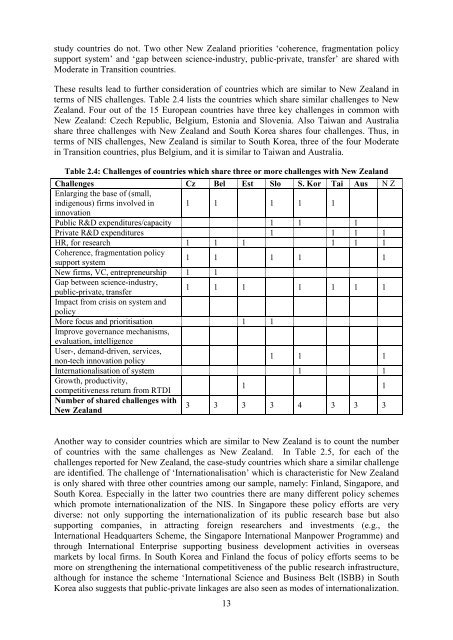Comparison of innovation policies in selected European, Asian and ...
Comparison of innovation policies in selected European, Asian and ...
Comparison of innovation policies in selected European, Asian and ...
You also want an ePaper? Increase the reach of your titles
YUMPU automatically turns print PDFs into web optimized ePapers that Google loves.
study countries do not. Two other New Zeal<strong>and</strong> priorities ‘coherence, fragmentation policy<br />
support system’ <strong>and</strong> ‘gap between science-<strong>in</strong>dustry, public-private, transfer’ are shared with<br />
Moderate <strong>in</strong> Transition countries.<br />
These results lead to further consideration <strong>of</strong> countries which are similar to New Zeal<strong>and</strong> <strong>in</strong><br />
terms <strong>of</strong> NIS challenges. Table 2.4 lists the countries which share similar challenges to New<br />
Zeal<strong>and</strong>. Four out <strong>of</strong> the 15 <strong>European</strong> countries have three key challenges <strong>in</strong> common with<br />
New Zeal<strong>and</strong>: Czech Republic, Belgium, Estonia <strong>and</strong> Slovenia. Also Taiwan <strong>and</strong> Australia<br />
share three challenges with New Zeal<strong>and</strong> <strong>and</strong> South Korea shares four challenges. Thus, <strong>in</strong><br />
terms <strong>of</strong> NIS challenges, New Zeal<strong>and</strong> is similar to South Korea, three <strong>of</strong> the four Moderate<br />
<strong>in</strong> Transition countries, plus Belgium, <strong>and</strong> it is similar to Taiwan <strong>and</strong> Australia.<br />
Table 2.4: Challenges <strong>of</strong> countries which share three or more challenges with New Zeal<strong>and</strong><br />
Challenges<br />
Enlarg<strong>in</strong>g the base <strong>of</strong> (small,<br />
Cz Bel Est Slo S. Kor Tai Aus N Z<br />
<strong>in</strong>digenous) firms <strong>in</strong>volved <strong>in</strong><br />
<strong><strong>in</strong>novation</strong><br />
1 1 1 1 1<br />
Public R&D expenditures/capacity 1 1 1<br />
Private R&D expenditures 1 1 1 1<br />
HR, for research 1 1 1 1 1 1<br />
Coherence, fragmentation policy<br />
support system<br />
1 1 1 1 1<br />
New firms, VC, entrepreneurship 1 1<br />
Gap between science-<strong>in</strong>dustry,<br />
public-private, transfer<br />
Impact from crisis on system <strong>and</strong><br />
policy<br />
1 1 1 1 1 1 1<br />
More focus <strong>and</strong> prioritisation<br />
Improve governance mechanisms,<br />
evaluation, <strong>in</strong>telligence<br />
1 1<br />
User-, dem<strong>and</strong>-driven, services,<br />
non-tech <strong><strong>in</strong>novation</strong> policy<br />
1 1 1<br />
Internationalisation <strong>of</strong> system 1 1<br />
Growth, productivity,<br />
competitiveness return from RTDI<br />
1 1<br />
Number <strong>of</strong> shared challenges with<br />
New Zeal<strong>and</strong><br />
3 3 3 3 4 3 3 3<br />
Another way to consider countries which are similar to New Zeal<strong>and</strong> is to count the number<br />
<strong>of</strong> countries with the same challenges as New Zeal<strong>and</strong>. In Table 2.5, for each <strong>of</strong> the<br />
challenges reported for New Zeal<strong>and</strong>, the case-study countries which share a similar challenge<br />
are identified. The challenge <strong>of</strong> ‘Internationalisation’ which is characteristic for New Zeal<strong>and</strong><br />
is only shared with three other countries among our sample, namely: F<strong>in</strong>l<strong>and</strong>, S<strong>in</strong>gapore, <strong>and</strong><br />
South Korea. Especially <strong>in</strong> the latter two countries there are many different policy schemes<br />
which promote <strong>in</strong>ternationalization <strong>of</strong> the NIS. In S<strong>in</strong>gapore these policy efforts are very<br />
diverse: not only support<strong>in</strong>g the <strong>in</strong>ternationalization <strong>of</strong> its public research base but also<br />
support<strong>in</strong>g companies, <strong>in</strong> attract<strong>in</strong>g foreign researchers <strong>and</strong> <strong>in</strong>vestments (e.g., the<br />
International Headquarters Scheme, the S<strong>in</strong>gapore International Manpower Programme) <strong>and</strong><br />
through International Enterprise support<strong>in</strong>g bus<strong>in</strong>ess development activities <strong>in</strong> overseas<br />
markets by local firms. In South Korea <strong>and</strong> F<strong>in</strong>l<strong>and</strong> the focus <strong>of</strong> policy efforts seems to be<br />
more on strengthen<strong>in</strong>g the <strong>in</strong>ternational competitiveness <strong>of</strong> the public research <strong>in</strong>frastructure,<br />
although for <strong>in</strong>stance the scheme ‘International Science <strong>and</strong> Bus<strong>in</strong>ess Belt (ISBB) <strong>in</strong> South<br />
Korea also suggests that public-private l<strong>in</strong>kages are also seen as modes <strong>of</strong> <strong>in</strong>ternationalization.<br />
13

















